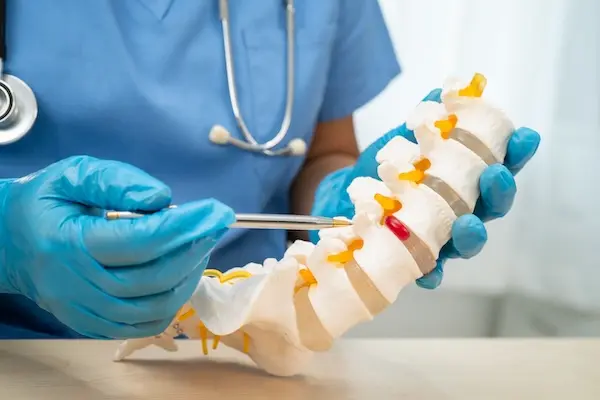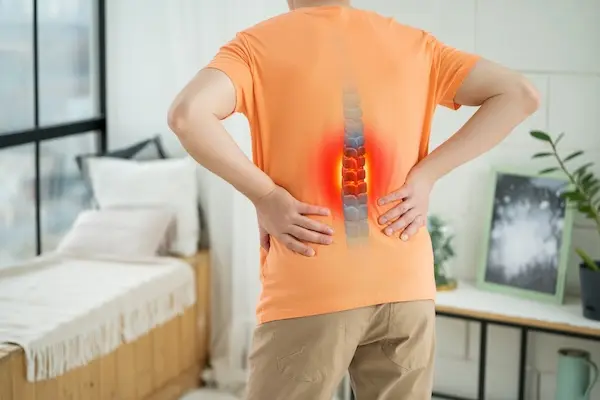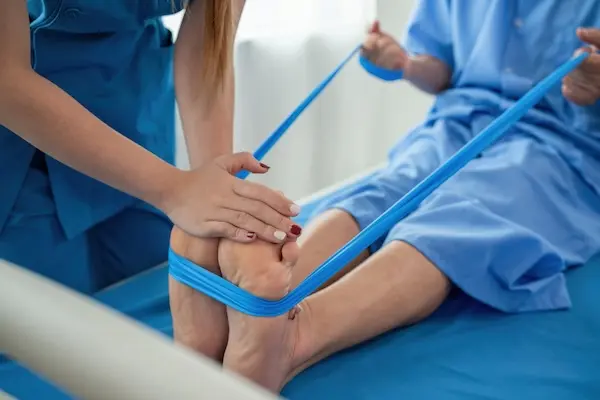Exploring Treatment Options for Degenerative Disc Disease
Degenerative disc disease is a common yet often misunderstood condition that affects millions of people worldwide. While it’s not actually a disease but a condition resulting from the natural wear and tear on spinal discs, it can lead to significant pain and disability. Fortunately, there are numerous degenerative disc disease treatment options available today. Choosing the right degenerative disc disease treatment depends on factors such as age, severity, and overall health. From conservative methods like physical therapy to cutting-edge regenerative medicine treatments, patients have more choices than ever for managing this chronic condition.
What Is Degenerative Disc Disease?
Degenerative disc disease (DDD) occurs when the spinal disks, which serve as shock absorbers between the vertebrae, begin to break down due to aging, repetitive stress, or injury. The condition can cause severe pain, stiffness, and reduced spinal flexibility. DDD can affect various parts of the spine, including the lumbar spine and cervical spine, potentially leading to chronic pain and complications like spinal stenosis or nerve compression. Early intervention with a tailored degenerative disc disease treatment can significantly improve mobility and reduce long-term complications.
Causes of Degenerative Disc Disease
Degenerative disc disease can arise from several factors, each playing a role in the gradual breakdown of spinal discs over time. While age is the most commonly recognized cause, other factors such as injury, lifestyle choices, and even genetics can contribute to the development and progression of this condition. Understanding the key causes of degenerative disc disease can help individuals make informed decisions about prevention and treatment. Below are some of the primary causes:
- Aging: Natural wear and tear is the most common cause. With age, spinal disks lose water content, becoming less flexible and more prone to damage.
- Injury: Trauma can damage a spinal disc and accelerate degeneration, often triggering a cycle of inflammation and breakdown.
- Repetitive Stress: Daily strain from physical activities or poor ergonomics can accelerate disc degeneration.
- Genetics: Studies show that genetic predisposition can influence the development and severity of disc degeneration.
- Excess Body Weight: Added pressure on the lumbar spine contributes significantly to disk degeneration.
Common Symptoms
Degenerative disc disease can manifest in various ways, with symptoms that may range from mild discomfort to severe, debilitating pain. These symptoms often affect the lower back or neck, but can also radiate to other parts of the body. Understanding the common signs of this condition is crucial for early diagnosis and effective management. Below are some of the most typical symptoms associated with degenerative disc disease:
- Chronic pain in the lower back or neck
- Pain that worsens with sitting, bending, or lifting
- Numbness or tingling in the extremities
- Muscle spasms and pinched nerves
- Persistent pain that radiates down the arms or legs
- Reduced spinal mobility
- Episodes of acute flare-ups causing severe pain
These symptoms often indicate the need for a comprehensive degenerative disc disease treatment to prevent further deterioration and restore function.
Types of Degenerative Disc Disease
Lumbar Degenerative Disk Disease
This type of degeneration affects the lower back region and is the most commonly diagnosed form of degenerative disc disease. The lumbar spine bears much of the body’s weight and is highly susceptible to wear and tear. Over time, the spinal disks in this region can lose hydration and elasticity, leading to:
- Chronic lower back pain
- Stiffness and reduced range of motion
- Pain radiating down the legs (sciatica) due to nerve root irritation
- Difficulty standing or sitting for extended periods
In more advanced cases, lumbar degeneration can lead to spinal stenosis, where the spinal canal narrows and compresses the spinal cord or nerve roots. This often causes persistent pain, numbness, tingling, and even motor weakness in the lower extremities.
Clinical Insight: A 2019 review published in The Spine Journal found that 65% of patients with lumbar degenerative disk disease experienced significant improvements in pain and function through a combination of nonsurgical treatments and physical therapy within one year. These findings support the effectiveness of nonsurgical degenerative disc disease treatment in managing lumbar spine issues.
Cervical Spine Degeneration
Cervical degenerative disc disease affects the neck region and is particularly impactful because of its proximity to the brain and upper spinal cord. The cervical spine supports the weight of the head and allows for a wide range of motion, which can also make it more prone to repetitive stress and wear. Key symptoms include:
- Neck pain and stiffness
- Radiating pain to shoulders and arms
- Numbness, tingling, or weakness in the arms and hands
- Muscle spasms
- Rarely, foot drop or coordination issues if the spinal cord is involved
Cervical disc degeneration can reduce spinal cord function and sometimes results in nerve compression. Left untreated, it may require surgical treatments to prevent permanent damage. An MRI often reveals the extent of disc degeneration, and treatment may involve everything from physical therapy to cervical spine fusion or artificial disc replacement.
Case Spotlight: A 46-year-old female teacher presented with recurring neck pain and right arm weakness. Imaging revealed multi-level cervical degenerative disc disease with moderate spinal stenosis. After six weeks of physical therapy and two epidural steroid injections, her symptoms improved significantly without requiring surgical intervention. Degeneration in the cervical spine can result in stiffness, nerve root compression, and symptoms such as numbness in the arms or foot drop. It may also reduce spinal cord function and require specific treatment strategies to prevent permanent damage. This case highlights how conservative degenerative disc disease treatment can offer substantial improvement without surgical intervention and how early-stage cervical degenerative disc disease treatment can deliver strong outcomes without surgery.
Diagnosis of Degenerative Disc Disease
Medical History & Physical Examination
Diagnosis begins with a comprehensive patient history and physical examination. Physicians gather detailed information about the onset, frequency, and intensity of symptoms, including the presence of severe pain, numbness, or reduced mobility. Patients are also evaluated for risk factors such as repetitive stress from occupational or recreational activities, excess body weight, prior spinal injuries, or a family history of disc disease.
The physical examination involves:
- Posture and Gait Analysis: Detects abnormalities in the spinal alignment.
- Palpation: Identifies tender points, muscle spasms, or tightness.
- Range of Motion Tests: Assesses flexibility and movement limitations.
- Neurological Evaluation: Checks for signs of nerve compression such as muscle weakness, altered reflexes, and sensory changes in the arms or legs.
A physical therapist may also contribute by evaluating muscular strength and coordination and recommending initial nonsurgical treatment strategies.
Imaging Tests
Imaging plays a pivotal role in confirming the diagnosis, identifying the location and severity of degeneration, and ruling out other conditions. Accurate imaging is essential for tailoring the most appropriate degenerative disc disease treatment.
- MRI Scans (Magnetic Resonance Imaging): The gold standard for assessing soft tissues, MRI reveals key indicators such as dehydrated or bulging discs, herniated discs, compressed nerve roots, and degenerative changes in the intervertebral spaces. It also helps visualize the spinal cord and any signs of spinal stenosis or nerve impingement.
- X-rays: While X-rays do not show soft tissues, they are essential for evaluating bone structure, spinal alignment, narrowing of disc spaces, and bone spurs. They can indicate instability or vertebral slippage (spondylolisthesis) that may accompany degenerative disc disease.
- CT Scans (Computed Tomography): Often used when MRI is not an option, CT scans provide highly detailed images of bony structures and are helpful in detecting subtle spinal canal changes, vertebral fractures, or the extent of disc degeneration in complex cases.
- Discography: In some cases, a discography may be performed to identify the specific disc causing pain. This involves injecting contrast dye into the disc under fluoroscopy to reproduce symptoms and confirm the pain source.
- Electromyography (EMG) and Nerve Conduction Studies: These tests measure the electrical activity in muscles and nerves to detect damage or pinched nerves caused by disc degeneration, especially when patients report radiating pain or numbness.
Early and accurate diagnosis is critical in developing an effective degenerative disc disease treatment plan that targets the source of pain and prevents progression to more severe complications. Once the source of pain is identified, the next step is developing a precise degenerative disc disease treatment tailored to the patient’s condition.
- MRI Scans: Show soft tissue damage, such as degenerated discs, herniated discs, and nerve compression.
- X-rays: Reveal changes in the alignment of the spinal column and disc height.
- CT Scans: Provide detailed images of the spinal canal and vertebrae structure.
Clinical Case Example
A 54-year-old male presented with persistent lower back pain for over a year. MRI revealed lumbar degenerative disk disease with a herniated disc at L4-L5. After a failed 6-month course of physical therapy and NSAIDs, the patient underwent anterior lumbar interbody fusion. Clinical outcomes included a 70% reduction in pain and improved mobility at a 12-month follow-up.
Degenerative Disc Disease Treatment Options
Nonsurgical Treatments
Physical Therapy
Customized physical therapy regimens are crucial in managing degenerative disc disease. A physical therapist designs a program to strengthen core muscles, relieve pressure on the spinal disks, and improve blood flow.
Case Study: A 38-year-old female with early-stage lumbar degenerative disk disease reported significant pain relief after 12 weeks of supervised physical therapy and cold therapy. Her Oswestry Disability Index improved by 40%, indicating increased functional capacity.
Pain Management Techniques
Managing pain is a key aspect of treating degenerative disc disease, as the discomfort can significantly impact daily life. Fortunately, there are several pain management techniques available that can help alleviate symptoms and improve quality of life. These methods range from medication to physical therapies, each offering relief depending on the severity of the condition. Below are some of the most commonly used pain management techniques:
- NSAIDs and Anti-Inflammatory Drugs: Reduce inflammation and pain signals.
- Muscle Relaxants: Effective for treating acute muscle spasms.
- Epidural Steroid Injections: Used to reduce inflammation near a nerve root; clinical data supports their efficacy for short-term relief.
- Massage Therapy: Helps manage chronic pain and muscle tension.
- Hot and Cold Therapy: Alternating between hot packs and ice can relieve pain and reduce inflammation.
Physical Medicine Approaches
Physical medicine focuses on restoring spinal cord function and managing pain through non-invasive methods such as ultrasound therapy, electrical stimulation, and chiropractic care.
Lifestyle Modifications
Maintaining a healthy weight, avoiding smoking, and correcting posture can slow disease progression and reduce pain.
Minimally Invasive and Surgical Treatments
When Surgery Is Necessary
Surgical intervention is considered when conservative degenerative disc disease treatment fails and patients experience debilitating symptoms, including nerve damage and chronic pain unresponsive to other therapies.
Spinal Fusion
This involves fusing one or more vertebrae to eliminate movement and reduce pain. Clinical outcomes show a high success rate for reducing pain but a loss of mobility at the fused segments.
Anterior Lumbar Interbody Fusion (ALIF)
This procedure approaches the spine from the front, removing the damaged disc and inserting a bone graft. A 2023 study reported improved clinical outcomes in 82% of patients who underwent ALIF with fewer complications compared to posterior approaches.
Artificial Disk Replacement
Artificial disk technology replaces a degenerated disc with a prosthetic device. It preserves motion and may lead to faster recovery than spinal fusion. Clinical data from a randomized trial found artificial disks reduced pain and disability with improved range of motion at 24-month follow-up.
Discectomy
A surgical procedure that removes part or all of a herniated or ruptured disk causing nerve compression. It’s often performed as a minimally invasive procedure with quicker recovery times.
Role of Regenerative Medicine
Regenerative medicine treatments such as stem cell therapy and platelet-rich plasma (PRP) injections are increasingly being used to treat degenerative disc disease. These emerging therapies are increasingly integrated into customized degenerative disc disease treatment plans for long-term relief.
Clinical Data: A study published in the Journal of Translational Medicine in 2022 followed 75 patients treated with intradiscal stem cell injections. After 6 months, over 60% of patients reported pain reduction of greater than 50% and increased mobility. These therapies aim to regenerate the inner core of the disc and restore function as part of an advanced degenerative disc disease treatment plan.
Pain Management and Long-Term Care
Developing a Comprehensive Treatment Plan
A successful degenerative disc disease treatment plan is not one-size-fits-all. It requires a comprehensive, multidisciplinary approach that addresses the root cause of the pain and supports long-term recovery. Health professionals involved may include orthopedic surgeons, neurologists, physiatrists, physical therapists, and pain management specialists.
Treatment plans are typically based on:
- The severity and location of disc degeneration
- Clinical imaging results and functional assessments
- Patient goals, such as returning to work or engaging in physical activities
- Medical history, including prior treatments and medications
Each plan often includes a combination of therapies tailored to promote healing, relieve pressure on spinal structures, improve spinal stability, and reduce chronic pain.
Chronic Pain Management
Managing chronic pain requires a multifaceted strategy to address physical symptoms, emotional well-being, and lifestyle factors. Common components include:
- Continued Physical Therapy: Structured programs target the strengthening of spinal stabilizer muscles, correcting posture, improving flexibility, and supporting spinal alignment.
- Cognitive-Behavioral Therapy (CBT): Helps patients manage psychological stress, anxiety, and depression commonly associated with chronic pain.
- NSAIDs and Anti-Inflammatory Drugs: Long-term use under medical supervision can help manage ongoing inflammation and pain signals.
- Muscle Relaxants: Prescribed to relieve muscle spasms and tension that can exacerbate discomfort.
- Massage Therapy and Acupuncture: These complementary therapies are often integrated to support relaxation and enhance blood flow.
- Pain Management Clinics: Multidisciplinary centers that offer specialized interventions such as radiofrequency ablation or spinal cord stimulation for persistent pain.
Each element plays a crucial role in sustaining the effects of initial degenerative disc disease treatment and preventing relapse.
Case Insight: A 61-year-old retired nurse with lumbar disc degeneration and persistent pain reported a 50% reduction in daily pain levels after three months of a combined regimen including physical therapy, anti-inflammatory medications, and CBT sessions. She avoided surgery and returned to her daily walking routine.
Monitoring Clinical Data
Ongoing monitoring is essential to determine whether a treatment plan is working or requires adjustment. Common tools include:
- Visual Analog Scale (VAS): A simple but effective tool for measuring pain intensity over time.
- Oswestry Disability Index (ODI): Measures the degree of disability and the impact of low back pain on daily life.
- Roland-Morris Disability Questionnaire (RMDQ): Assesses physical limitations due to back pain.
- Follow-up MRI and Imaging: Used to evaluate structural changes in spinal discs, spinal canal narrowing, or response to regenerative treatments.
Patient-reported outcomes and clinical metrics guide physicians in optimizing care, ensuring the treatment plan continues to meet individual needs, and preventing unnecessary surgical interventions whenever possible.
- Continued physical therapy
- Cognitive-behavioral therapy to manage psychological stress
- Long-term use of NSAIDs under physician supervision
Monitoring Clinical Data
Routine imaging and pain assessments help track disc degeneration and guide adjustments to the treatment plan. Tools like the Visual Analog Scale (VAS) and Oswestry Disability Index are commonly used to evaluate clinical outcomes. These assessments ensure that the degenerative disc disease treatment remains effective and can be adjusted as needed.
Preventing Degenerative Disc Disease
While no strategy guarantees prevention, habits that support spinal health also enhance the success of degenerative disc disease treatment.
Exercise and Stretching
Regular stretching and core-strengthening exercises reduce stress on the spinal disks and prevent progression.
Ergonomic Practices
Adjusting workspaces, using lumbar support, and taking breaks during prolonged sitting can help prevent developing degenerative disk disease.
Avoiding Risk Factors
Avoiding smoking, reducing body weight, and maintaining healthy spinal habits are key to preventing disc disease.
Take the Next Step Toward Pain-Free Living with VeriSpine Joint Centers
Degenerative disc disease is a leading cause of chronic back and neck pain, but it doesn’t have to define your life. With accurate diagnosis and a personalized degenerative disc disease treatment plan, lasting relief is within reach. From effective nonsurgical solutions like physical therapy and pain management to minimally invasive surgical interventions and state-of-the-art regenerative medicine treatments, there are more paths than ever to reclaiming your mobility and comfort.
At VeriSpine Joint Centers, our multidisciplinary team of spine specialists is committed to helping you achieve optimal outcomes through customized treatment strategies backed by the latest clinical data. We focus on reducing pain, restoring spinal function, and enhancing your quality of life using advanced diagnostics and innovative therapies tailored to your unique condition. VeriSpine specializes in advanced degenerative disc disease treatment tailored to your individual condition and goals
Don’t let degenerative disc disease control your daily routine or limit your future. Take the first step toward a pain-free life—schedule a consultation with VeriSpine Joint Centers today 678-782-7999 and discover how our proven approach to spinal care can help you move better, feel better, and live better.








